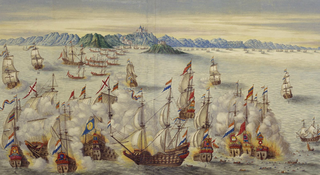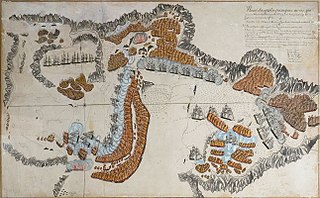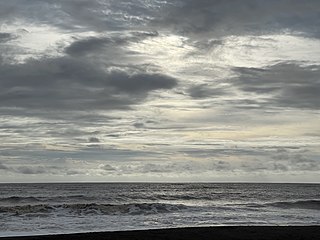
The Spanish-Portuguese War between 1735-1737 was fought over the Banda Oriental, roughly present-day Uruguay.

São João Baptista, nicknamed Botafogo ("Spitfire"), was a Portuguese galleon built in the 16th century, around 1530, considered the biggest and most powerful warship in the world by Portuguese, Castillian, and Italian observers of the time.

The Battle of Cape St Vincent of 1641 took place on 4 November 1641 when a Spanish fleet commanded by Don Juan Alonso de Idiáquez y Robles intercepted a Dutch fleet led by Artus Gijsels during the Eighty Years' War. After a fierce battle two Dutch ships were lost but the Dutch claimed only a hundred of their men were killed; the Spanish fleet also lost two ships but over a thousand dead. The damaged Dutch fleet was forced to abandon its planned attack on the Spanish treasure fleet.

The action of 14 October was a naval engagement of the First World War when the Imperial German Navy submarine SM U-139 attacked the Portuguese civilian steamer São Miguel and the Portuguese Navy naval trawler NRP Augusto de Castilho in the Atlantic Ocean on 14 October 1918.
The Battle of Dabul was a retaliatory attack by the forces of the Viceroy of Portuguese India, Francisco de Almeida, upon the port city of Dabul in the Sultanate of Bijapur. It occurred on 29 December 1508, in retaliation for attacking the Portuguese armada en route to the Battle of Diu. Despite the presence of a double wooden wall and a ditch, the Portuguese using both an artillery bombardment and a pincer movement of armed soldiers, "slammed into the town. What followed was a black day in the history of European conquest that would leave the Portuguese cursed on Indian soil." The conquerors were merciless--all living creatures were slaughtered then the city set on fire to burn alive those who had managed to hide in secret. The Portuguese departed on January 5, 1509. "This massacre stood beside [Vasco de] Gama's destruction of [the Hajj pilgrim ship] the Miri as an unforgiven act that lingered long in the memory".
The Battle of Calicut took place between the Portuguese ship of the line Nossa Senhora da Misericórdia, commanded by João de Melo Saraiva and 21 Maratha ships that attempted to conquer the city of Calicut. The Portuguese were victorious and managed to make the Marathas retreat.

The Battle of Goa refers to a series of naval engagements between the Portuguese Armada and the Dutch East India Company fleets attempting to blockade and conquer the city of Goa. In 1638, forces commanded by the Viceroy of Portuguese India, D. Pedro da Silva and later António Teles de Meneses, fought off a large Dutch fleet sent to block the port colony of Goa, commanded by Admiral Adam Westerwolt, who was badly defeated at this encounter. The next year 1639, the Dutch Admiral Cornelis Simonsz van der Veere would conduct a new raid on Goa's port.

The siege of Mombasa was an attack on the Portuguese city of Mombasa and Fort Jesus by the army of the Ya'rubid ruler of Oman, Saif I bin Sultan, from 13 March 1696 to 13 December 1698.

The Battle of the Tiger's Mouth was a series of engagements between a Portuguese flotilla stationed in Macau, and the Red Flag Fleet of the Chinese pirate Ching Shih, led by her second-in-command, Cheung Po Tsai - known to the Portuguese as Cam Pau Sai or Quan Apon Chay. Between September 1809 and January 1810, the Red Flag Fleet suffered several defeats at the hands of the Portuguese fleet led by José Pinto Alcoforado e Sousa, within the Humen Strait - known to the Portuguese as the Boca do Tigre - until finally surrendering formally in February 1810. After her fleet surrendered, Ching Shih surrendered herself to the Qing government in exchange for a general pardon, putting an end to her career of piracy.

The battle of Hormuz or the battle of the Persian Gulf on 11–12 February 1625 was "perhaps the largest naval battle ever fought in the Persian Gulf". It pitted a Portuguese force against a combined force of the Dutch East India Company (VOC) and English East India Company (EIC). Although the battle was a draw, the result was the loss of Portuguese influence in the Gulf.

The Battle of El Tor was a military engagement that took place in 1541, between Portuguese forces under the command of the Governor of India Dom Estevão da Gama and those of the Ottoman Empire then in the city of El Tor, on the Sinai Peninsula. The Turks were driven from the city, but at the request of Christian monks from the Monastery of Saint Catherine the Portuguese spared the city from being plundered, and celebrated a mass and a knighting ceremony therein.

The siege of Colonia del Sacramento took place between October 1735 and September 1737, during the Spanish–Portuguese War (1735–1737).

The Battle of Surat was fought on 2 February 1704, off Surat, India, by a Portuguese squadron of one ship of the line and seven frigates, commanded by Jorge de Sousa de Meneses, and an Omani squadron of nine ships of the line and frigates.
Charrua is a Portuguese nautical expression of the Age of Sail, initially used to designate the use of a frigate or a ship of the line owned by the State as a transport ship, reducing armament and complement, like the French nautical expression en flûte.

Malay–Portuguese conflicts were military engagements between the forces of the Portuguese Empire and the various Malay states and dynasties, fought intermittently from 1509 to 1641 in the Malay Peninsula and Strait of Malacca.

Acehnese–Portuguese conflicts were the military engagements between the forces of the Portuguese Empire, established at Malacca in the Malay Peninsula, and the Sultanate of Aceh, fought intermittently from 1519 to 1639 in Sumatra, the Malay Peninsula or the Strait of Malacca. The Portuguese supported, or were supported, by various Malay or Sumatran states who opposed Acehnese expansionism, while the Acehnese received support from the Ottoman Empire and the Dutch East India Company.

The Battle of Daman took place on 23 March 1694, when a Portuguese squadron, commanded by General António Machado de Brito, pursued and attacked an Omani squadron sailing off Daman.
The Battle of Mamora (1696) took place in the summer of 1696 between the Portuguese and Moroccan fleets off the coast of Mamora. The Portuguese left the battle victorious after repelling several Muslim vessels.
The Action of 29 November 1726 was a minor naval battle fought between a Portuguese ship of the line defending three merchant ships from two Algerian pirate ships off the Portuguese coast.
The Action of 26 May 1789 was a minor naval engagement fought off Algiers, Mediterranean Sea, in which a small Portuguese division spotted an Algerian xebec accompanied by a French ship that he had captured, the Le Désir, which he was forced to abandon and flee.














